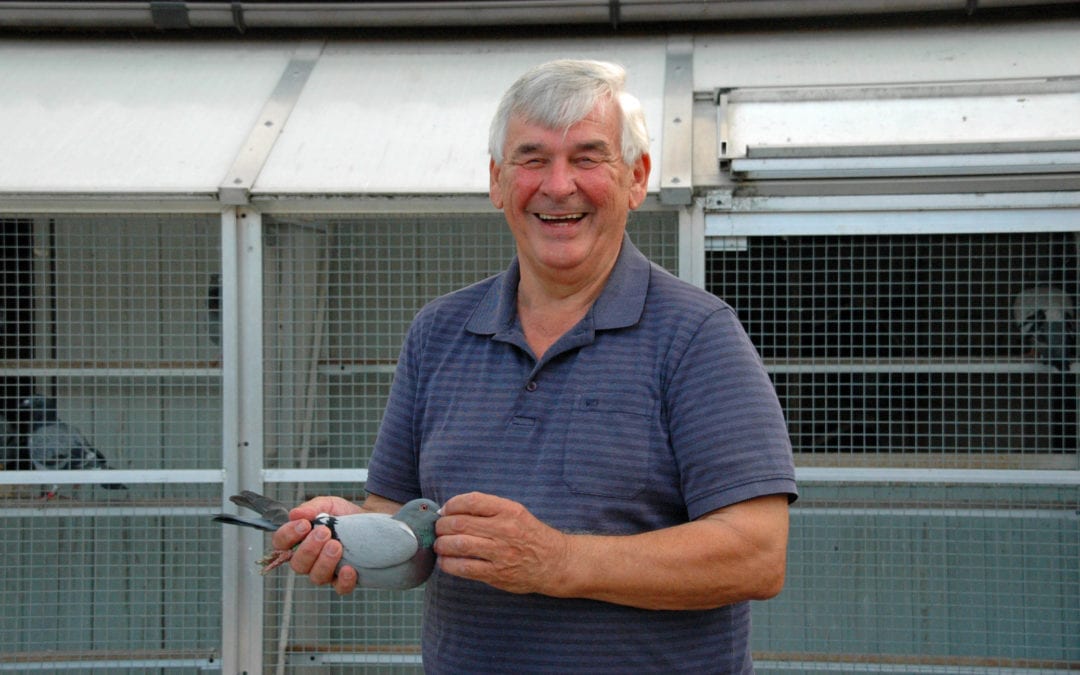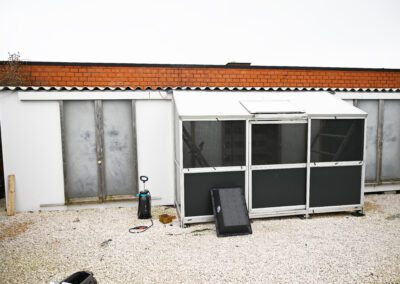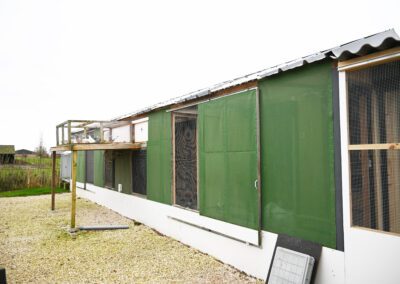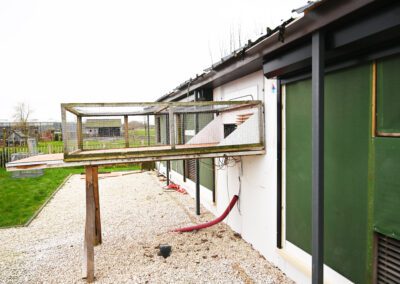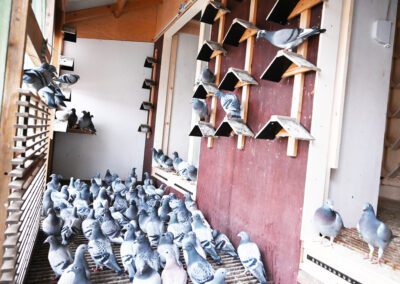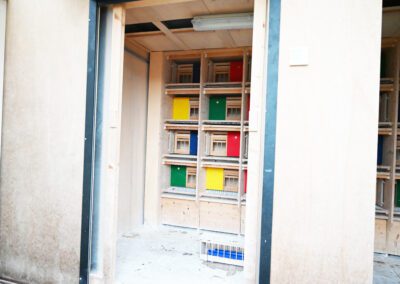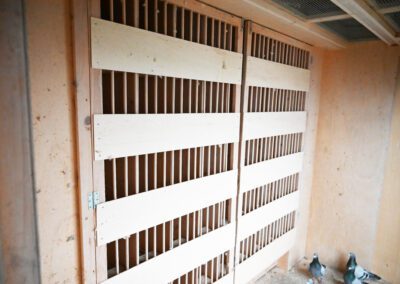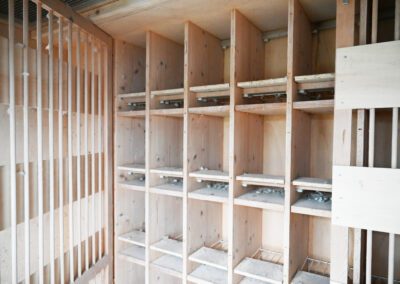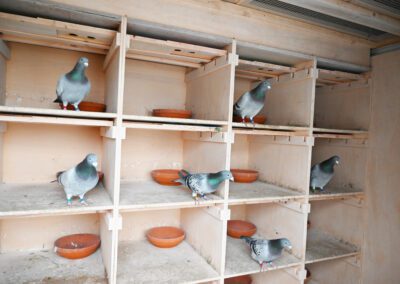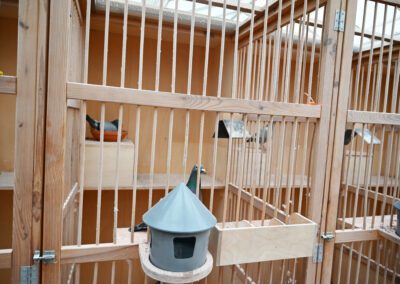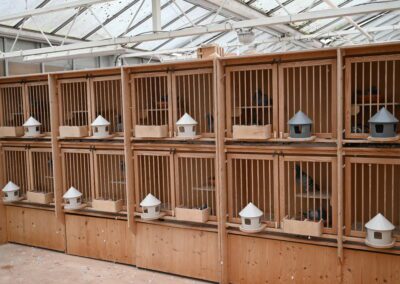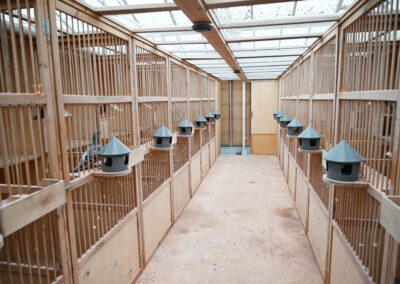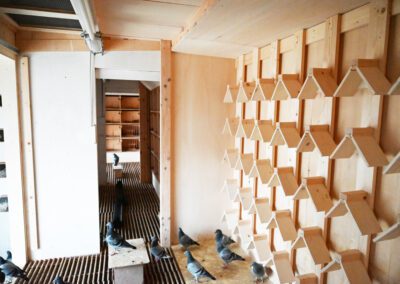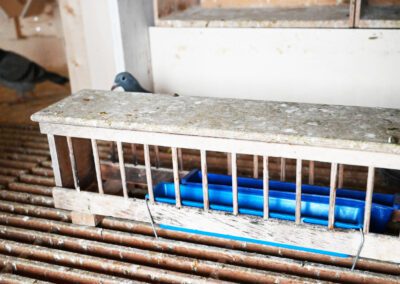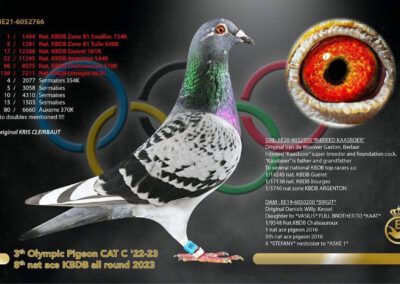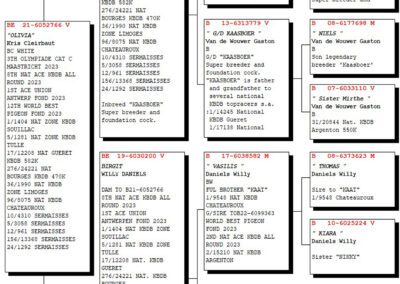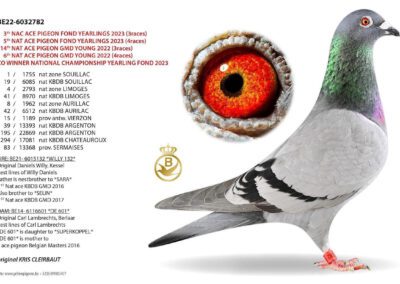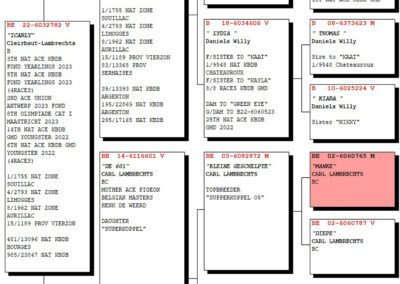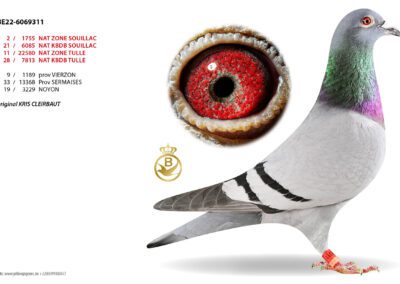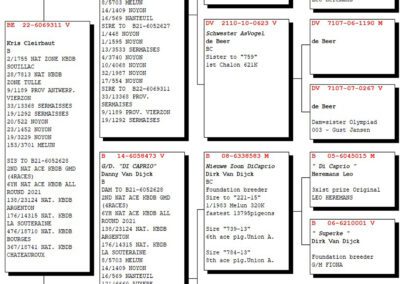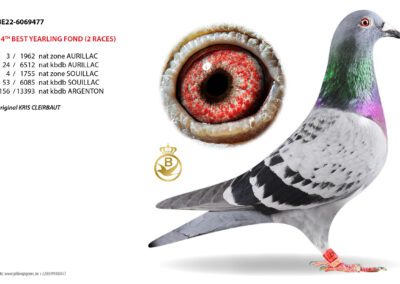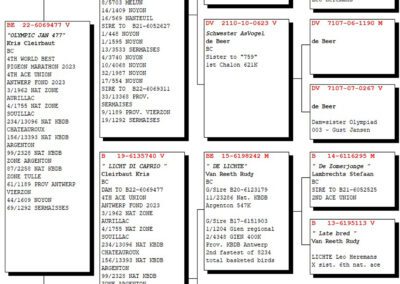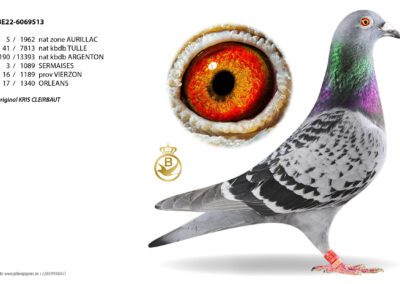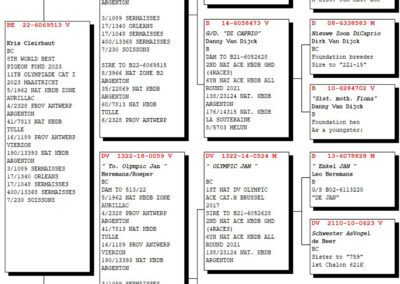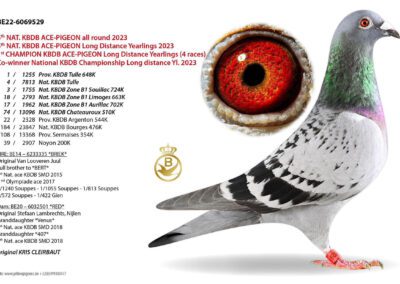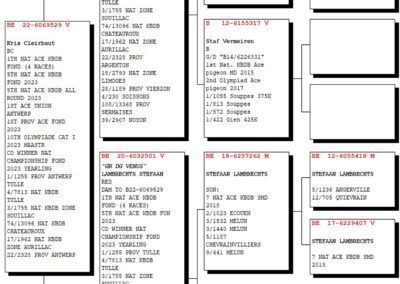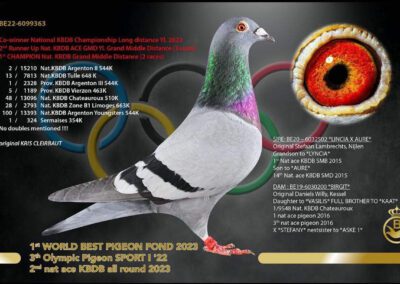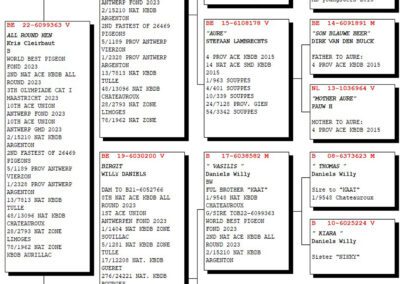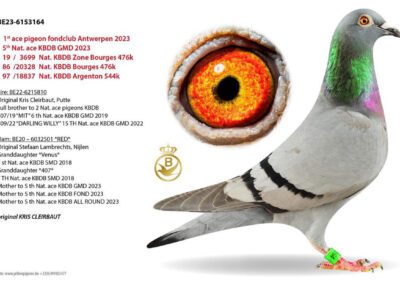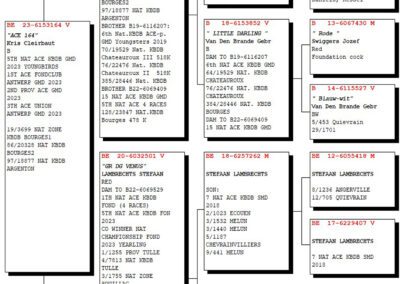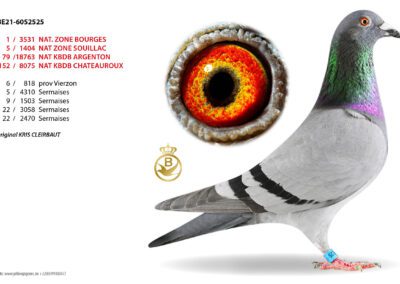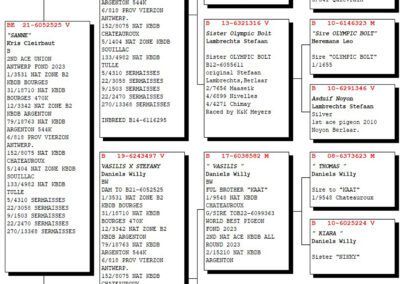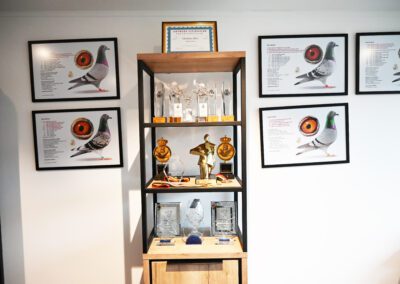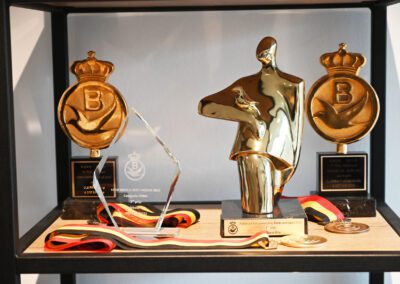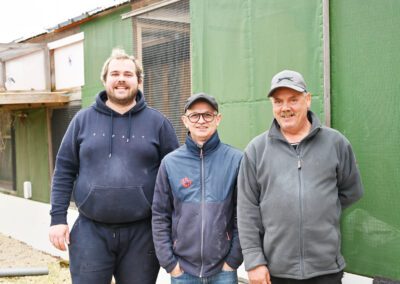DERWA-LUXEM (Herent)
1st National champion great middle distance KBDB old- and year birds
2nd National ace great middle distance KBDB old birds
Albert Derwa… always ready for a funny remark needs no introduction. Many of his top birds, including his internationally known “Paulien”, made him world-famous. The 2020 season was again one of a highest level. A summary teaches us that on the national races for old and yearlings 133 birds were basketed. Of these, 87 won in the first 10% of the result (= 67%) and 30 Top-100 national rankings (= 23%) were clocked. Rarely seen and difficult to match. Look at the results which are mentioned at the end of this report.
The basis of the Derwa colony has been the same for years and the last few years the Hooymans pigeons (line “Harry”) have provided a “performance boost”. Hen “Davinia” is the current favorite of Albert and he hopes a bit that this will become his new “Paulien”. And of course, the triplet. Grandfather “Invictus” wins 1st Nat Issoudun (16,615 youngsters), daughter “Irina” wins 1st Nat Argenton (3,322 yearlings) and granddaughter “”Irissa” also wins 1st Nat Argenton (4,606 old / also fastest 27,892 pigeons). What a luxury to have such class birds at your disposal.
Only with hens
Albert starts his story: “Many people think that I sit in my loft all day. The opposite is true. As little as possible. What does a fancier do in his loft? Tell me honestly. For a fancier, it’s poison. Don’t forget: those hens are also a bit paired with me. When I come to the loft, they start to spin. When I talk to them, they start to mate. That is not good. My hens are unlocked (free) in the loft and that’s why I have two lofts for the hens. One loft for nine hens and another loft for twelve. When they start to pair, I can switch and when it gets too bad, they disappear in a special “hens’ box” in which they can be closed because eggs are not allowed. Racing with the hens is my greatest pleasure and many people won’t believe me, but I act on feeling. I feed by feeling, I let the hens train by feeling, I’m like a different fancier every day. But I admit: if it wouldn’t work and the results wouldn’t come, I would talk differently. Now I dare to say: we all do too much. Ninety-nine per cent of the fanciers is proud when their pigeons train hard. I am the one who thinks differently. Two times one and a half hour a day, I can’t think of it. Then you spend three hours a day with the old birds and then the young ones still must go outside. My hens train twice a day for 10 to 15 minutes. Before the season of course more but once they are in the season, they think more about their cock and they go faster to the drop board. For me, no problem if they perform well on Saturday.
The racing hens (6 old, 15 yearlings) I put together half January. That corresponds with the second round of the breeders. When the youngsters from the breeders are ten days old, I pair the racers. My racing hens are paired with cocks that did well as youngsters. In 2020, my young cocks won more first prizes than the hens. Also, because they entered the loft better. Sometimes the youngsters arrived with ten equal and then the cocks came in first. With 21 hens on the race loft, the selection is very easy. It is a luxury problem. I do not want more. Keeping the overview is very important. All respect for people who race with a hundred or more birds, but it does not suit me.” “A champion bird makes the fancier. There are people who think I have secrets. What I don’t understand at all is that some of those people who think that, used to race very hard themselves. Then I bounce the question back. When you raced so hard, did you also give something special? The answer is invariably “I gave nothing, but times have changed.” It even goes so far that people who are not doing so well start tearing down their lofts. I don’t understand that. My shed, 13 meters altogether, is from 1966.”
System
Every year Albert tries to bring his birds in a perfect condition at the start of a new season.
At the end of February the hens are vaccinated against paramyxo (1x). At the beginning of March, a “cure” against paratyphoid is planned with Parastop or Paracoli for 7 to 8 days. After the cure, 3 days of B.T. Amin Forte will follow. One week later, a 7-day treatment with “Tricho Groen” against trichomonas and then again 3 days of B.T. Amin Forte. One week later, there is a treatment with Soludox (7 to 10 d) against respiratory infections and then again 3 days of Amin Forte.
When the youngsters are weaned, pure barley is fed for 3 to 4 weeks. After that, we switch to 50% barley + 50% Gaby Vandenabeele. One week before the races, the pigeons get 7 days of Blitz in their drink.
“I only feed once a day. Also, the pigeons from the great middle distance. In the morning after the training, I only give grit, peeled sunflower seeds and hempseed. The hens are fed in a common feeder. In the youngsters’ loft, I don’t want any feeding troughs. Then I feed everything on the floor. They also must build up resistance. The only meal is in the evening, half an hour before the training. The training of the racing hens only takes fifteen minutes. If it would take longer, I would regret the loss of energy. It is better to save it for the flight day.
When they come home from the short distance races on Saturday, they are fed “Galaxy Light”. From Sunday to Tuesday, it becomes 100% barley. On Wednesday and Thursday, 50% barley + 50% Galaxy Light. On Friday, 50% Gaby Vandenabeele + 50% Galaxy Light.
On Saturday, when they come back from the middle distance, they give them Galaxy Light + GEM (Recovery). On Sunday, the food will be 50% barley + 50% Gaby Vandenabeele. Then Hexenbier + “health mixture” is added to the corn. Albert had the product BCK made. BCK contains all the wanted ingredients plus brewer’s yeast, ginger, and a number of vitamins.
On Monday and Tuesday it will be 100% Gaby Vandenabeele and on Wednesday and Thursday 100% Galaxy Light.
When they come home from the great middle distance, they use Galaxy Light + GEM. On Sunday, 50% barley + 50% Gaby Vandenabeele and BCK on the feed.
On Monday and Tuesday, 100% Gaby Vandenabeele is put in the feeder, on Wednesday 100% Galaxy Light and on Thursday two feeds of Brilliant. Every morning the pigeons get peeled sunflower seeds and hempseed. The pigeons for short, middle-distance, and very long distance are fed once a day.
The youngsters are fed more lightly and receive 2/3 Olympia young pigeon feed with 1/3 barley. The youngsters that are raced on the middle-distance also get Brilliant and GEM.
The hens are housed in two lofts of 5.5 m together, the youngsters in two lofts of 5 m together. During the racing season, the lofts are cleaned twice a day. There is no big cleaning anymore, but the lofts are regularly cleaned with the flame.
Last races of the season on nest
Albert smoothly continues: “At the beginning of August I bring the hens on nest. Because Argenton II was cancelled due to the heat, I raced the hens twice at 40 km. “Irissa”, later national winner and fastest of 29,108 pigeons was like a tigress on her nest. I will never forget her arrival. We were watching… Via the registration site of the KBDB we knew that the first pigeons reached 1270 m/m, and then she arrived… 1308 meters. For a pigeon fancier the most beautiful thing there is. It was not only “Irina” who flew well, the whole hens team performed exceptionally strong although they were mainly basketed on youngsters’ of 4/5 days old.
Nesting hens can get an extra push. When the babies get grain, I put the cocks in the box the last two days before basketing. I like to have two youngsters in the nests. Then the hens moult slower. Hens on nest also train twice a day. When they are fed before the training, I close all the boxes. I hang perches in front of the boxes but too high to catch the youngsters that come to beg. When the hens are training, the cocks come to the loft for 15 minutes to feed their youngsters. With this system, the hens save strength, and they go fuller into the basket. I do not have enough eyes in a pigeon loft. I feel good when I see the fire starting at the basketing during the season when the cocks come to the loft. Putting a nest in a corner of the loft can also work. For those moments, I have a box under which it is almost dark, and the party goes on. We do not know why they come home early but it is for something.”
Young birds
“Racing hens is my favorite game but racing young birds is also big fun. The youngsters are mainly bred from the breeders and the best racers. They are weaned at 24 to 25 days. The youngsters are darkened from 15 March to 21 June, from 18 to 8 in the morning. Lighting is not done the last two years. According to my experience, there is no difference
Concerning training tosses, the youngsters go from 2km to 30 km in 20 to 25 times. At 10 km, the pigeons must be at home for the Albert and only then he continues. Sometimes they must be released 3 to 4 times at 10 km.
The young cocks are in a loft with classical living boxes, the hens are on perches. Training is done with a roller system. In the morning at 10 o’clock, the young hens train first. The cocks then go to the loft of the hens, the hens enter the loft of the young cocks, the cocks are released, and the hens come back to their own loft.
Cocks and hens stay together till the first Soissons (160km) has been raced. Then the sliding door is introduced, and many couples are formed. Then the loft is equipped with creeping boxes. When basketing for races with one night basket, the young partners come together for 1 hour, for races with two nights basket, they come together for 4 to 5 hours.
Between the races, the youngsters are fed three times a week. Once they get to middle distance, they are no longer transported in between. An exception is made when the youngsters have a bad race behind them.
We love to introduce you:
“Davina” B18-2093024 ♀
Won in 3 racing seasons following prizes 1/100 (without doubles)
1 Argenton 1,878b.
1 Momignies 622b.
3 Melun 9,009b.
4 Nat. La Souterraine 9,469b.
4 Blois 683b.
4 Chateauroux 2,472b.
4 Chateauroux 1,888b.
6 Nat. Issoudun 10,603b.
7 Soissons 1,601b.
9 Momignies 944b.
9 Momignies 1,467b.
10 Nat. Montluçon 14,104b.
15 Blois 3,277b.
24 Issoudun 2,868b.
58 Nat. Bourges 23,191b.
66 Nat. Chateauroux 20,800b.
“Robby” B18-2088799 ♀
Won in 3 racing seasons following prizes 1/100 (without doubles)
2 Nat. La Souterraine 9,469b.
2 Salbris 2,420b.
3 Nanteuil 793b.
4 Chateauroux 5,306b.
4 Momignies 1,467b.
4 Soissons 1,338b.
5 Argenton 1,878b.
7 Soissons 1,095b.
8 Soissons 1,601b.
14 Blois 3,277b.
15 Nat. Argenton 16,762b.
63 Nat. Issoudun 10,603b.
“Tine” B19-2039030 ♀
Won in 2 racing seasons following prizes 1/100 (without doubles)
4 Etampes 1,256b.
4 Etampes 3,393b.
6 Soissons 605b.
7 Sermaises 1,616b.
63 Nat. Chateauroux 33,833b.
72 Nat. Argenton 26,085b.
183 Nat. Issoudun 18,176b.
Some top results racing season 2020
14.6 Melun, 2,769b. : 1, 2, 9, 28, 30, 56, 58, 133, 166, 266, 266, 344, 417, 430, 639,… (15/20)
20.6 Sermaises, 2,692b.: 1, 2, 12, 13, 15, 17, 18, 126, 129, 206, 252, 290, 370, 420, 537, 724, 847 (17/20)
04.7 Chateauroux, National 20,800 old birds : 24, 66, 188, 2744, 4920 (5/5)
33,833 year birds : 5, 6, 63, 156, 406, 664, 929, 1042, 1832, 3139, 3552 (11/15)
11.7 Argenton, National 16.762 oude : 15, 143, 603, 1159 (4/5)
26,085 year birds: 72, 83, 176, 267, 411, 791, 4132, 4458, 4612 (9/15)
11.7 Momignies, 2,337 young birds: 1, 1, 4, 6, 7, 8, 9, 11, 17, 22, 23, 24, 61, 66, 68, 89, 93, 94, 94, 97, 103, 109, 113, 116, 124, 155, 159, 198, 266… (40/68)
18.7 Issoudun, 429 old birds : 1, 7, 15, 47 (4/5) 681 year birds : 1, 2, 4, 5, 8, 19, 33, 90, 177, 197 (10/10)
18.7 Momignies, 2,311 young birds: 2, 3, 5, 6, 7, 8, 10, 11, 14, 18, 21, 22, 23, 42, 46, 50, 60, 64, 65, 68, 72, 121, 126, 131, 139, 140, 220, 224, 282, 290, 290, 290… (40 /67)
25.7 La Souterraine, National 9,469 oude : 2, 4, 53, 350 (4/5)
15,939 year birds: 177, 225, 266, 282, 400, 527, 580, 1370, 2241, 2555, 4077 (11/11)
01.8 Soissons, 2,808 young birds : 1, 2, 2, 2, 2, 6, 7, 7, 9, 25, 26, 44, 44, 46, 58, 69, 87, 102, 103, 105, 109, 110, 130, 134, 143, 143, 180, 216, 369… (45/68)
22.8 Sermaises, 397b.: 1, 3, 4, 6, 7, 9, 10, 19… (9/16)
22.8 Sermaises, 1,092 young birds: 3, 4, 5, 6, 12, 13, 15, 18, 27, 31, 33, 35, 41, 42, 88, 89, 140,… (24/59)
30.8 Soissons, 1358 young birds: 1, 2, 3, 4, 5, 6, 7, 12, 14, 15, 15, 15, 18, 19, 20, 22, 23, 32, 34, 34, 34, 37, 38, 39, 41, 42, 50, 57, 58, 64, 76, 79, 82, 86, 91… (50/61)
06.9 Argenton, National 4606 old birds: 1, 4, 12, 14, 29, 48, 70, 72, 166, 218, 295, 338, 417, 495 (14/16)
12.9 Laon, 363 birds: 1, 1, 3, 4, 4, 6, 7, 8, 8, 10, 10, 12, 13, 15, 20, 21, 22, 23, 23, 25, 26,… (39/46)
